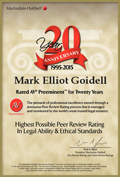By Mark Goidell, Esq.
Nassau Lawyer
Click here to view PDF
Claims of employment discrimination or hostile work environment/harassment in religious affiliated institutions compete against the Free Exercise and Establishment Clauses of the First Amendment. The legal principles guiding this conflict are starting to emerge although much clarity is still required. Mark’s article discusses the current status of the ministerial exception and remaining issues in its application to employment claims.
Printed with permission by the Nassau County Bar Association
The ministerial exception bars discrimination and retaliation claims arising from the employment decision of religious institutions regarding “ministers.” The exception has its genesis in both the Free Exercise Clause and Establishment Clause of the First Amendment: “Congress shall make no law respecting an establishment of religion, or prohibiting the free exercise thereof.”1 The Free Exercise Clause safeguards religious institutions’ “right to shape [their] own faith and mission through [their] appointments,” and the Establishment Clause prohibits “government involvement in [ ] ecclesiastical decisions.”2 Together, they “bar the government from interfering with the decision of a religious group to fire one of its ministers.”3
The reach of the doctrine has expanded over the past two years. The Supreme Court held that elementary school teachers in a parochial school were “ministers” and applied the ministerial exception to dismiss their state and federal discrimination claims arising from the termination of their employment in Our Lady of Guadalupe v. Morrissey-Berru.4
Whether the doctrine precludes hostile work environment and harassment claims in addition to tangible action claims is still undecided by the Supreme Court. The Court signaled in Morrissey-Berru that the ministerial exception may shield religious institutions from more than just tangible employment decisions, holding that “courts are bound to stay out of employment disputes involving those holding certain important positions with churches and other religious institutions.”5
On July 9, 2021, the Seventh Circuit Court of Appeals applied the ministerial doctrine to dismiss hostile work environment claims regardless of whether the employer subjected a plaintiff to any tangible employment action in Demkovich v. St. Andrew the Apostle Parish, Calumet City.6
It thereby joined the Tenth Circuit Court of Appeals in precluding such claims. There is contrary authority from the Ninth Circuit Court of Appeals. Before discussing these decisions, some background on the doctrine and its parameters is important.
Religious Institutions
The determination of whether an employer is a religious institution has not been very controversial. Of course, the term includes churches, mosques, synagogues, gurdwaras, and other places of congregational worship. The term also encompasses a “religiously affiliated entity [whose] mission is marked by clear or obvious religious characteristics.”7 Religious schools were therefore protected in Morrissey-Berru and many other cases. The ministerial doctrine also shielded a Christian organization whose purpose is to advance the understanding and practice of Christianity on college campuses,8 a nursing home which declared its mission to provide elder care to Jewish patients,9 and the pastoral care department of a hospital with religious affiliation.10
Ministers
In Morrissey-Berru, the Supreme Court broadly defined employees who are within the ambit of “ministers.” In determining whether employees at religious schools are ministers, the Supreme Court explained that the core consideration is their “role in conveying the Church’s message and carrying out its mission.”11 “[E]ducating young people in their faith, inculcating its teachings, and training them to live their faith are responsibilities that lie at the very core of the mission of a private religious school.”12 Thus, the Supreme Court held that many teachers at religious schools qualified as “ministers” for the purposes of the exception even though they were not considered formal ministers.
Justice Alito, writing for the majority of the Supreme Court, set forth the rationale for holding that the plaintiffs-elementary school teachers were “ministers” whose employment discrimination claims were barred. The religious education and formation of students is the very reason for the existence of most private religious schools, and therefore the selection and supervision of the teachers upon whom the schools rely to do this work lie at the core of their mission. Judicial review of the way in which religious schools discharge those responsibilities would undermine the independence of religious institutions in a way that the First Amendment does not tolerate.13
Eight years earlier, in Hossana- Tabor, the Supreme Court applied four non-exhaustive factors to determine that the plaintiff-teacher there was a “minister”: “the formal title given [plaintiff] by the Church, the substance reflected in that title, her own use of that title, and the important religious functions she performed for the Church.”14 In Morrissey-Berru, the Court rejected an analysis limited to these four factors.15 Instead, the duties and responsibilities of the teachers as set forth in the faculty handbooks and school mission statements were dispositive. The Court noted that “the academic requirements of a position may show that the church in question regards the position as having an important responsibility in elucidating or teaching the tenets of the faith.”16 “What matters, at bottom, is what an employee does.”17 The Court then recited the evidence implicating the ministerial exception:
There is abundant record evidence that they both performed vital religious duties. Educating and forming students in the Catholic faith lay at the core of the mission of the schools where they taught, and their employment agreements and faculty handbooks specified in no uncertain terms that they were expected to help the schools carry out this mission and that their work would be evaluated to ensure that they were fulfilling that responsibility. As elementary school teachers responsible for providing instruction in all subjects, including religion, they were the members of the school staff who were entrusted most directly with the responsibility of educating their students in the faith. And not only were they obligated to provide instruction about the Catholic faith, but they were also expected to guide their students, by word and deed, toward the goal of living their lives in accordance with the faith. They prayed with their students, attended Mass with the students, and prepared the children for their participation in other religious activities… And both their schools expressly saw them as playing a vital part in carrying out the mission of the church, and the school’s definition and explanation of their roles is important.18
Finally, the Court ended its decision with the following rule: “When a school with a religious mission entrusts a teacher with the responsibility of educating and forming students in the faith, judicial intervention into disputes between the school and the teacher threatens the school’s independence in a way that the First Amendment does not allow.”19
Hostile Work Environment and Harassment Claims
While there is no longer any doubt that the ministerial exception bars the adjudication of “employment disputes” arising from discrimination and retaliation claims by “ministers” against religious institutions for tangible employment actions, federal circuits are split as to whether the ministerial exception also applies to hostile work environment claims against religious institutions by “ministers.” The Supreme Court’s description of cases barred by the ministerial exception appears to be sufficiently broad to prohibit such claims.
The Tenth Circuit barred hostile work environment claims under the ministerial exception in Skrzypczak v. Roman Catholic Diocese of Tulsa. 20 On the other hand, the Ninth Circuit reached a different conclusion in Elvig v. Calvin Presbyterian Church. 21 In November 2021, however, the Ninth Circuit retreated somewhat from its position. It now applies the ministerial exception to hostile work environment claims that are “so intertwined with the employment decisions that the claims cannot be separated.”22 On July 9, 2021, the Seventh Circuit issued its en banc decision in Demkovich,23 which joined the Tenth Circuit in holding that the ministerial exception categorically bars employees who qualify as ministers from asserting hostile work environment claims against the religious organizations that employ them. The plaintiff served as a music director, choir director and organist for a church. He asserted hostile work environment claims against his employer based on derogatory comments his supervisor made about his physical conditions and sexual orientation. The court dismissed the hostile work environment claims on the grounds that “[a]djudicating Demkovich’s allegations of minister-on-minster harassment would not only undercut a religious organization’s constitutionally protected relationship with its ministers, but also cause civil intrusion into, and excessive entanglement with, the religious sphere.”24
“The protected interest of a religious organization in its ministers covers the entire employment relationship, including hiring, firing and supervising in between.”25 The court held that “[a] religious organization’s supervision of its ministers is as much a component of its autonomy as is the selection of the individuals who play certain key roles,” and thus, “it would be incongruous if the independence of religious organizations mattered only at the beginning (hiring) and the end (firing) of the ministerial relationship, and not in between (work environment).”26
The Demkovich court held that the ministerial exception applies to hostile work environment claims by ministers regardless of whether or not religious doctrine is implicated by the allegations. The court explained that “[h]ow one minister interacts with another, and the employment environment that follows, is a religious, not judicial prerogative,”27 and “[i]n these sensitive areas, the state may no more require a minimum basis in doctrinal reasoning than it may supervise doctrinal content.”28 The court therefore held that “[j]ust as a religious organization need not proffer a religious justification for termination claims, a religious organization need not do so for hostile work environment claims.”29
The Demkovich court also rejected the assertion that applying the ministerial exception to hostile work environment claims would somehow permit sexual assault and other illegal treatment of the individuals the institution has hired. The court explained that while the ministerial exception applies to employment claims, it does not protect against criminal or personal tort liability.30 The court stated that “analogies to tort law fail to recognize that a hostile work environment claim brings the entire ministerial relationship under invasive examination,” and that “[t]ort liability—unlike liability for employment discrimination claims— generally does not arise as a direct result of the protected ministerial relationship.”31 Accordingly, Demkovich’s employment claims based on offensive and derogatory comments by his supervisor were dismissed.32
Demkovich did not seek review by the Supreme Court and the action is therefore conclusively terminated in favor of the defendant religious institution. No other circuit court has published a decision addressing the issue since Demkovich. Neither the Second Circuit nor any New York state court has determined whether the ministerial exception bars hostile work environment or harassment claims by “ministers” against religious institutions.
Conclusion
Cases testing the limits of the ministerial exception are currently pending. Whether religious school employees such as guidance counselors or coaches are “ministers” is still to be determined. So too, the issue of whether the ministerial exception applies to claims for gender-based or other unlawful harassment under the New York State and New York City Human Rights Laws is undecided. The tension between these statutory protections and the Free Exercise Clause and Establishment Clause of the First Amendment will be the subject of evolving caselaw.
1. U.S. Const. Amend. I.
2. Hosanna-Tabor Evangelical Lutheran Church &
School v. EEOC, 565 U.S. 171, 181 (2012).
3. Id. at 188.
4. 591 U.S. __, 140 S. Ct. 2049, 2060 (2020).
5. Id., 140 S. Ct. at 2060 (emphasis added).
6. 3 F.4th 968 (7th Cir. 2021).
7. Condon v. Intervarsity Christian Fellowship, 777
F.3d 829, 834 (6th Cir. 2015) (quotation marks
omitted).
8. Id.
9. Shaliehsabou v. Hebrew Home of Greater
Washington, Inc., 363 F.3d 299, 310 (4th Cir. 2004).
10. Penn v. New York Methodist Hospital, 884 F.3d
416, 424 (2d Cir. 2018).
11. 140 S.Ct. at 2063.
12. Id. at 2064.
13. Id. at 2055.
14. Hosanna-Tabor, 565 U.S. at 192.
15. Morrissey-Berru, 140 S.Ct. at 2063-2064.
16. Id. at 2064.
17. Id.
18. Id. at 2066.
19. Id. at 2069.
20. 611 F.3d 1238, 1245 (10th Cir. 2010). Two
other circuit court decisions are cited as cases that
preclude hostile work environment claims under
the ministerial doctrine, but both cases actually
presented tangible action claims. Gellington v.
Christian Methodist Episcopal Church, 203 F.3d 1299,
1300-1301 (11th Cir. 2000); Combs v. Central Texas
Annual Conference of United Methodist Church, 173
F.3d 343, 350-351 (5th Cir. 1999).
21. 373 F.3d 941 (9th Cir. 2004).
22. Orr v. Christian Brothers High School, Inc., __ F.3d
__, 2021 WL 5493416, at *2 (9th Cir. Nov. 23,
2021).
23. The en banc decision reversed an earlier
decision of a panel of the Seventh Circuit rejecting
the ministerial exception for plaintiff’s hostile work
environment claims. Demkovich v. St. Andrew the
Apostle Parish, Calumet City, 973 F.3d 718 (7th Cir.
2020).
24. Demkovich, 3 F.4th at 977-978.
25. Id. at 976-977.
26. Id. at 979 (quotation mark omitted).
27. Id. at 980.
28. Id. at 982 (quotation marks omitted).
29. Id. at 980.
30. Id. at 983.
31. Id.
32. Id. at 985.









